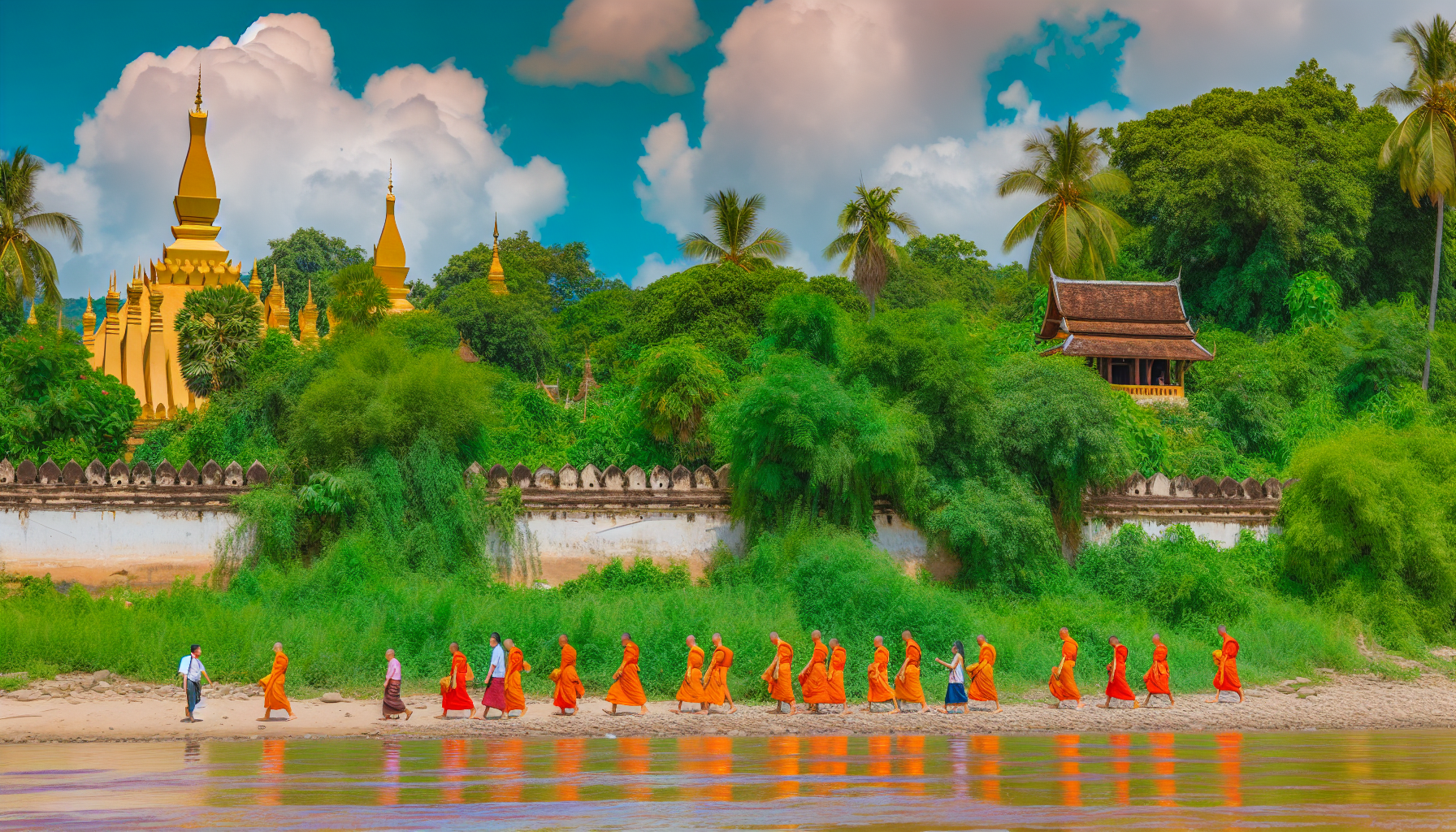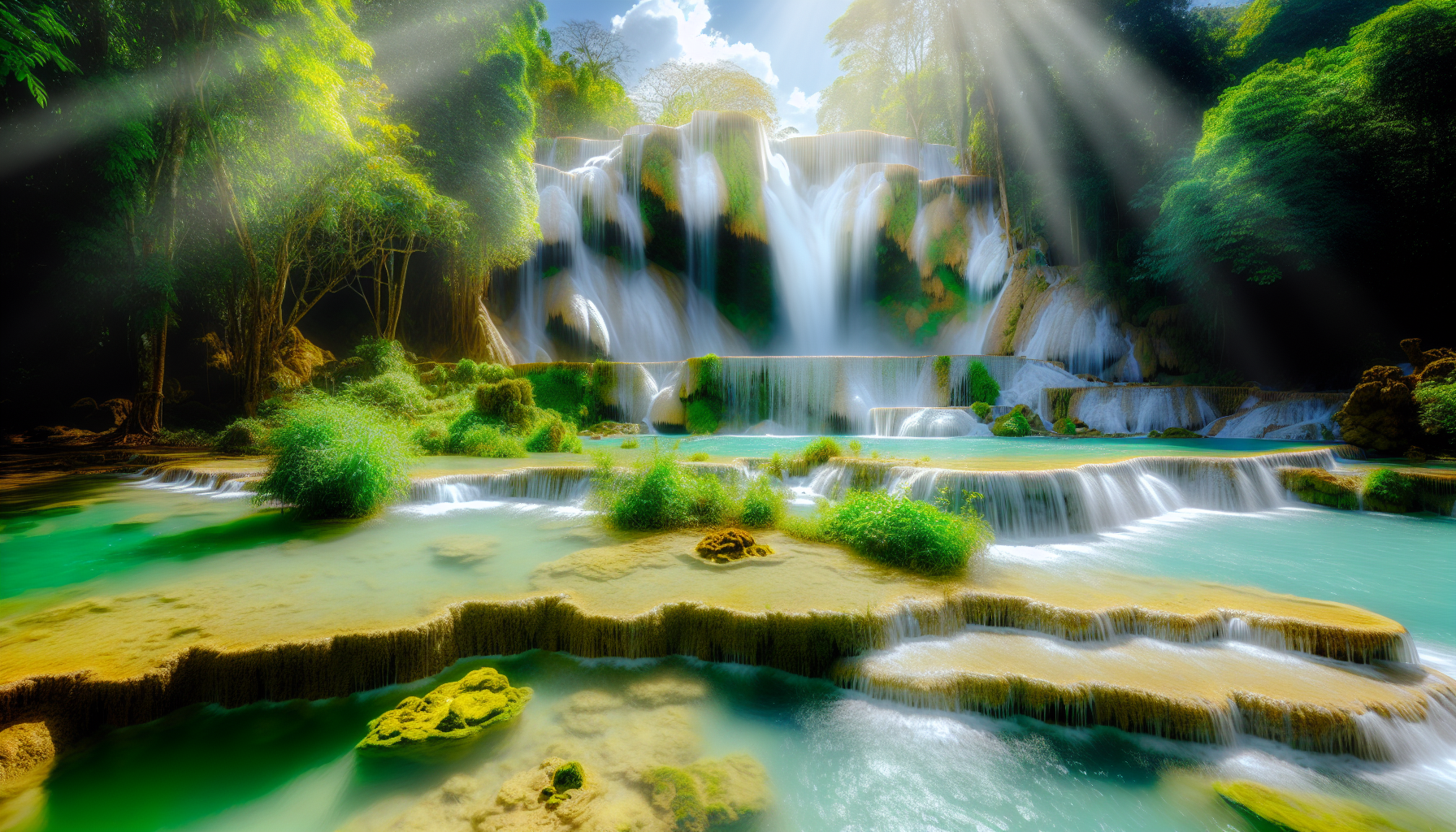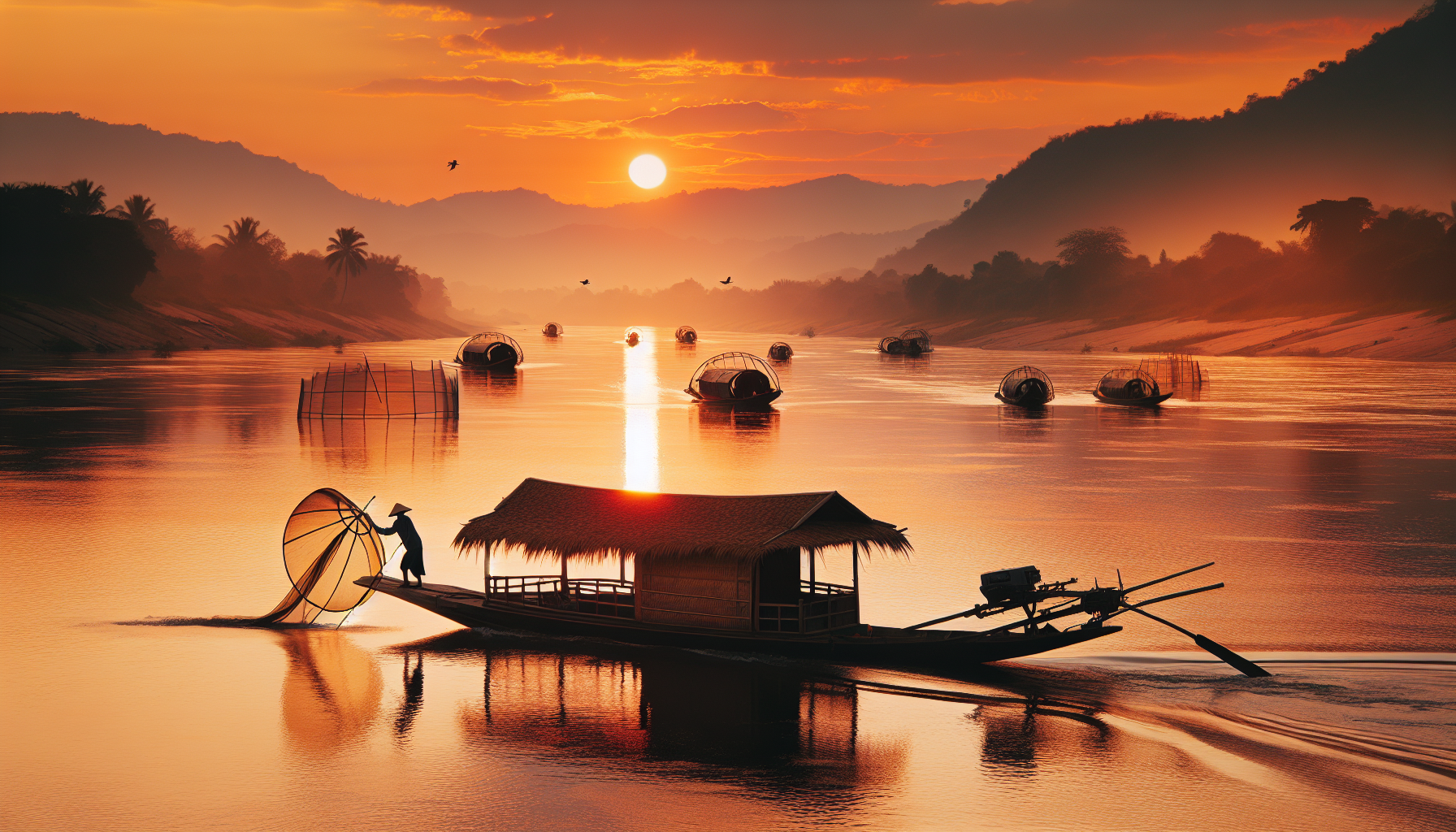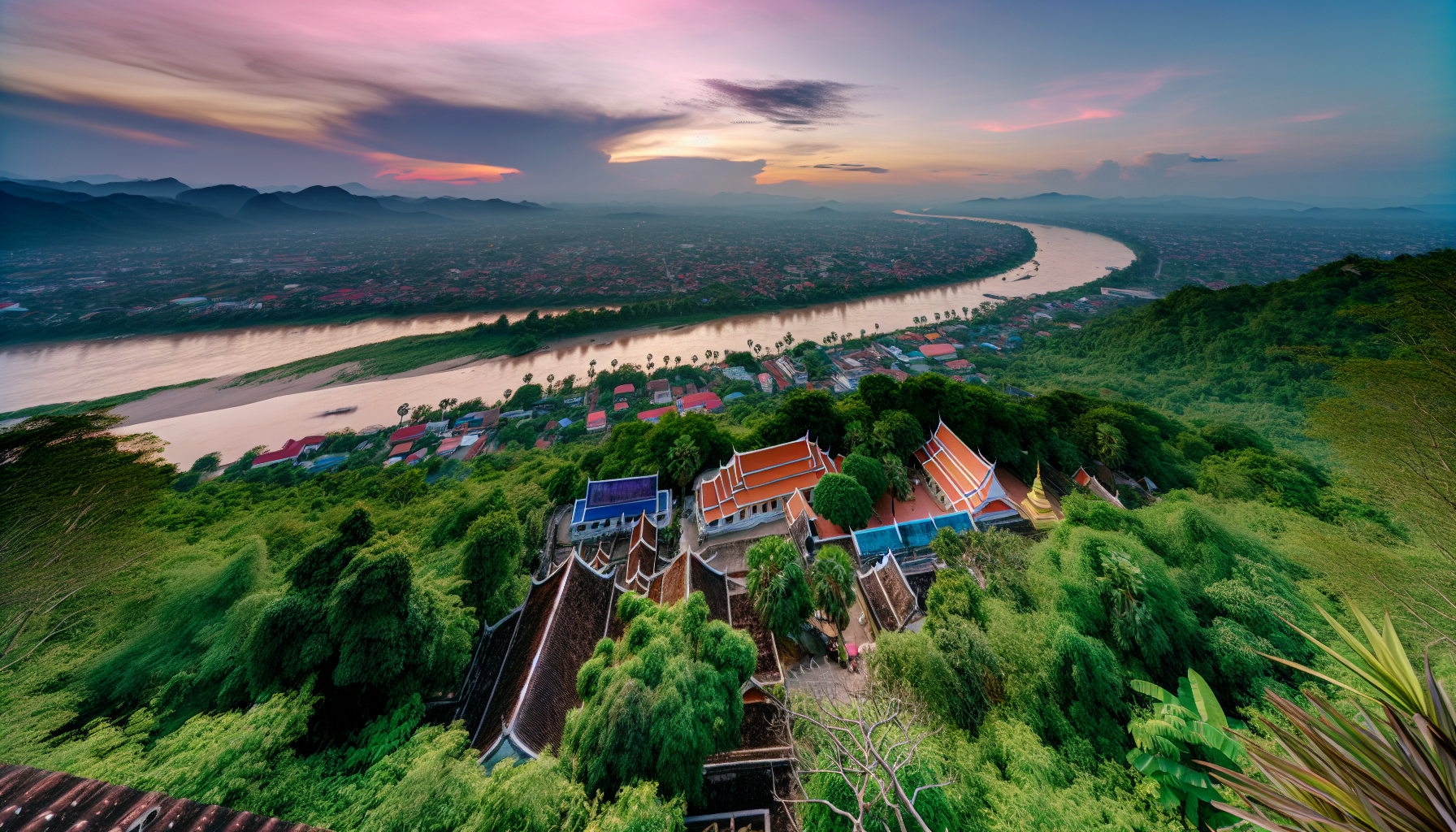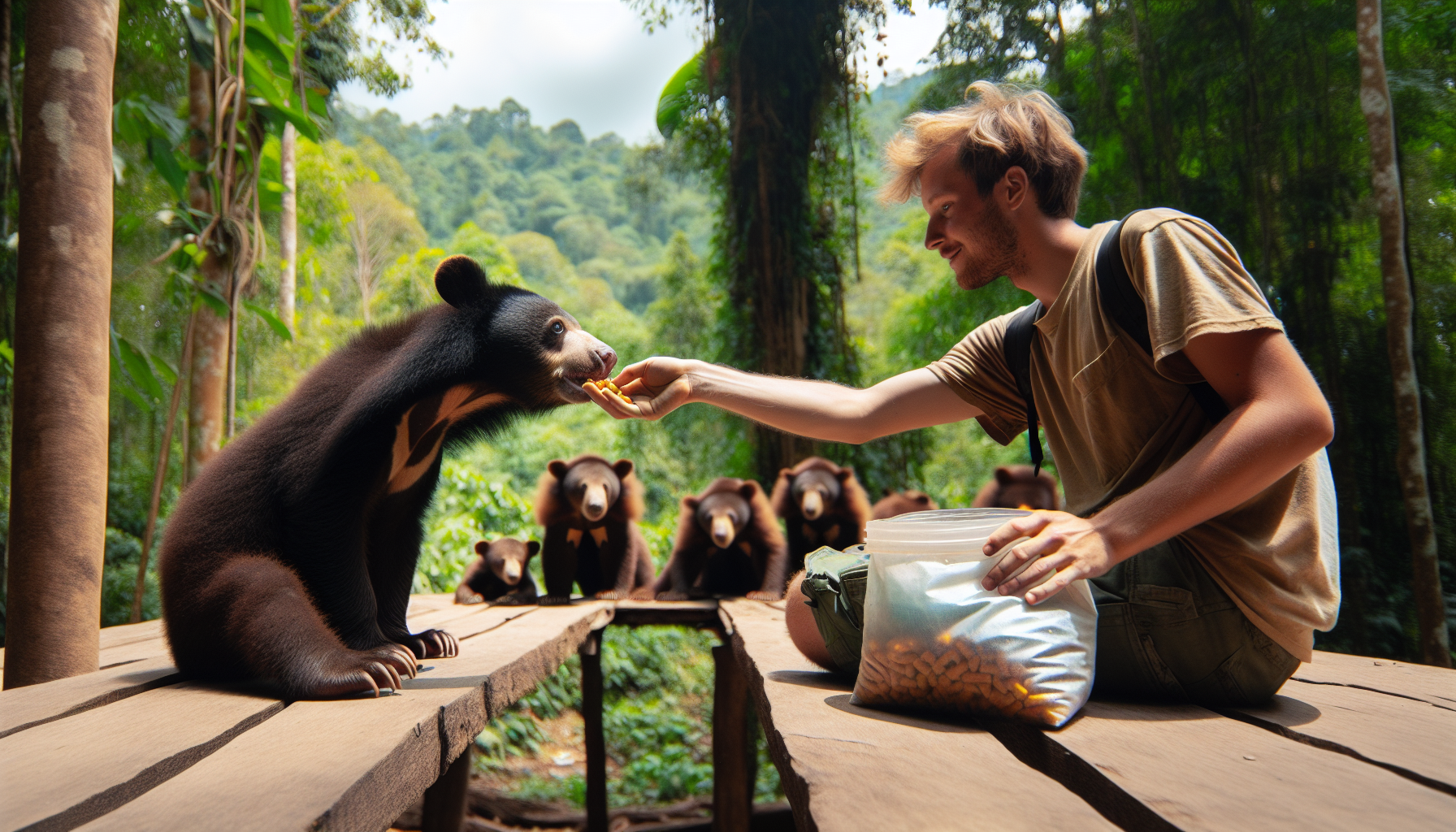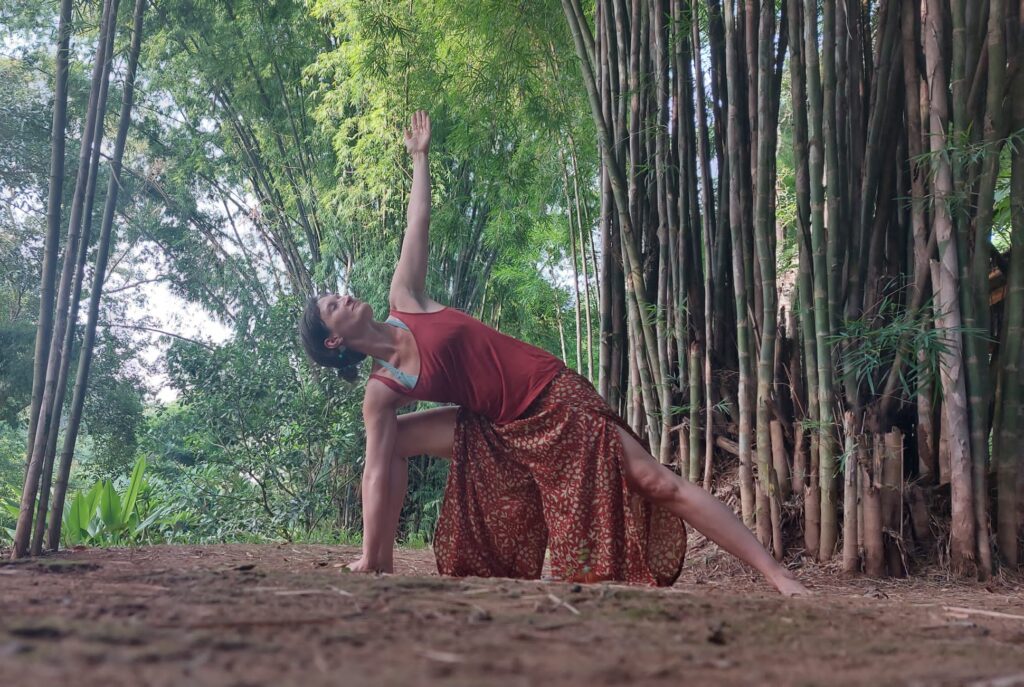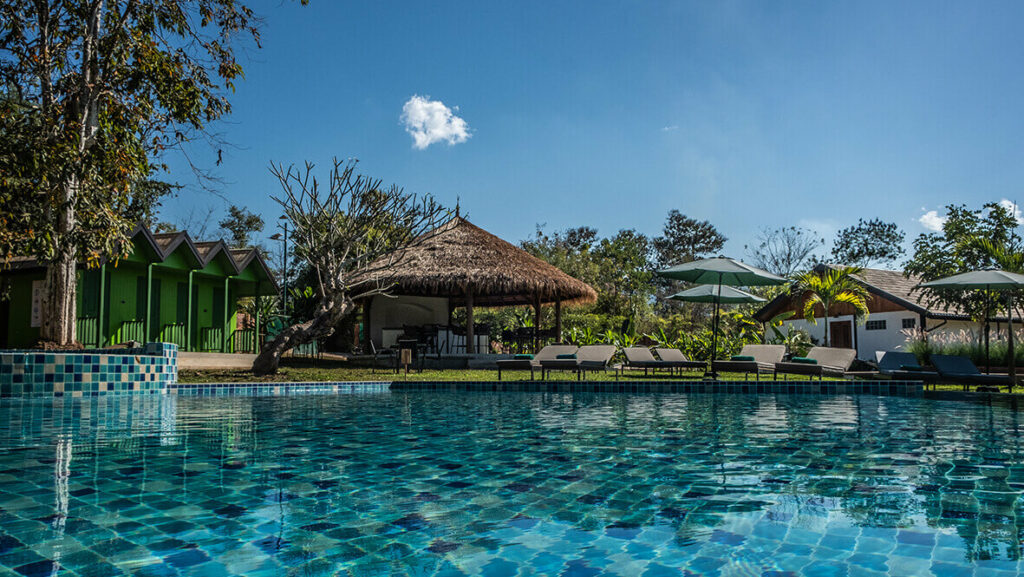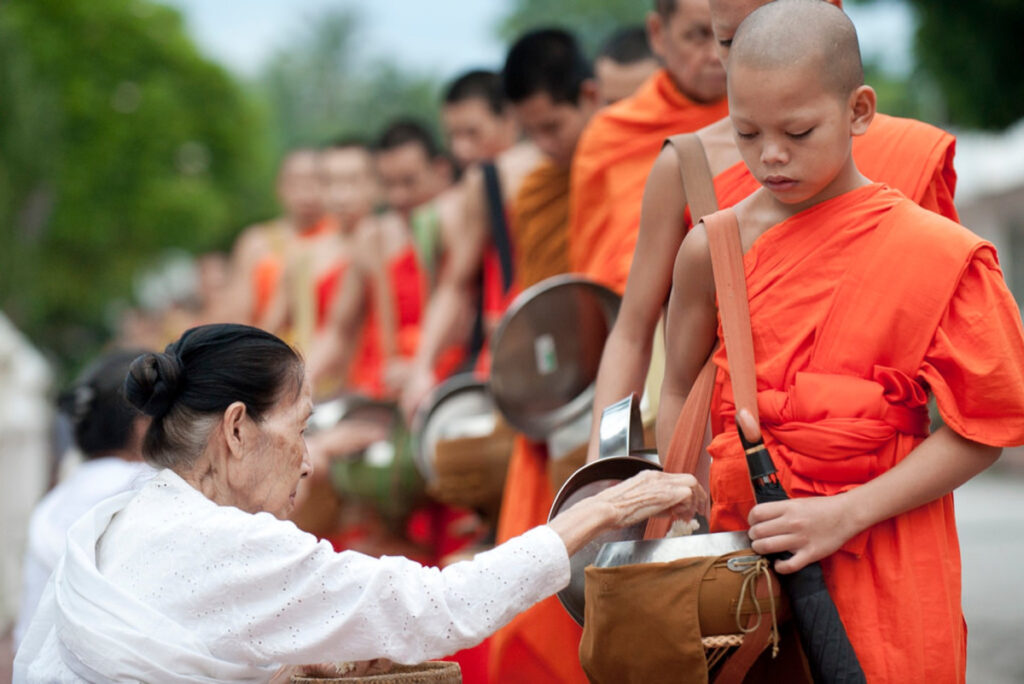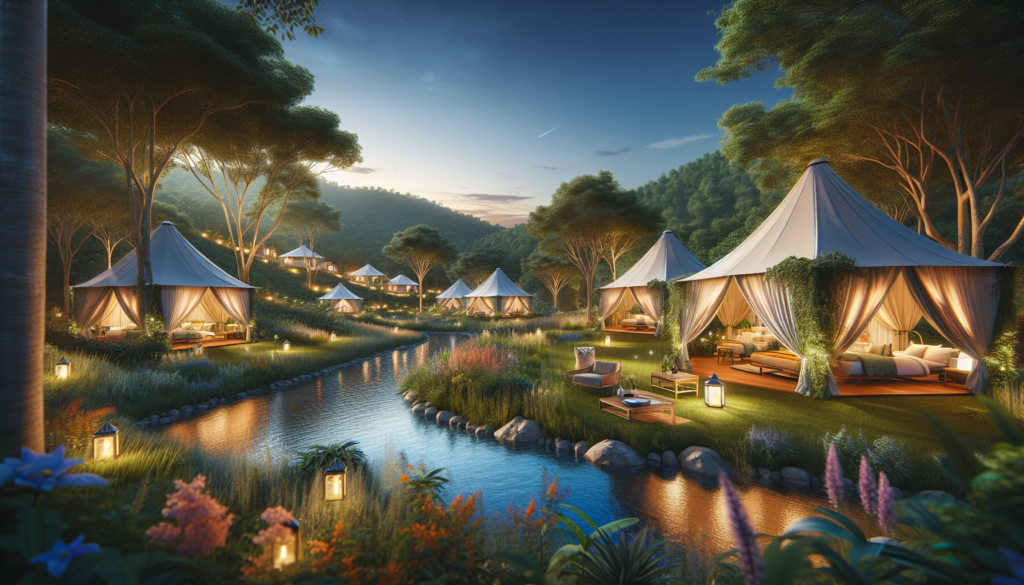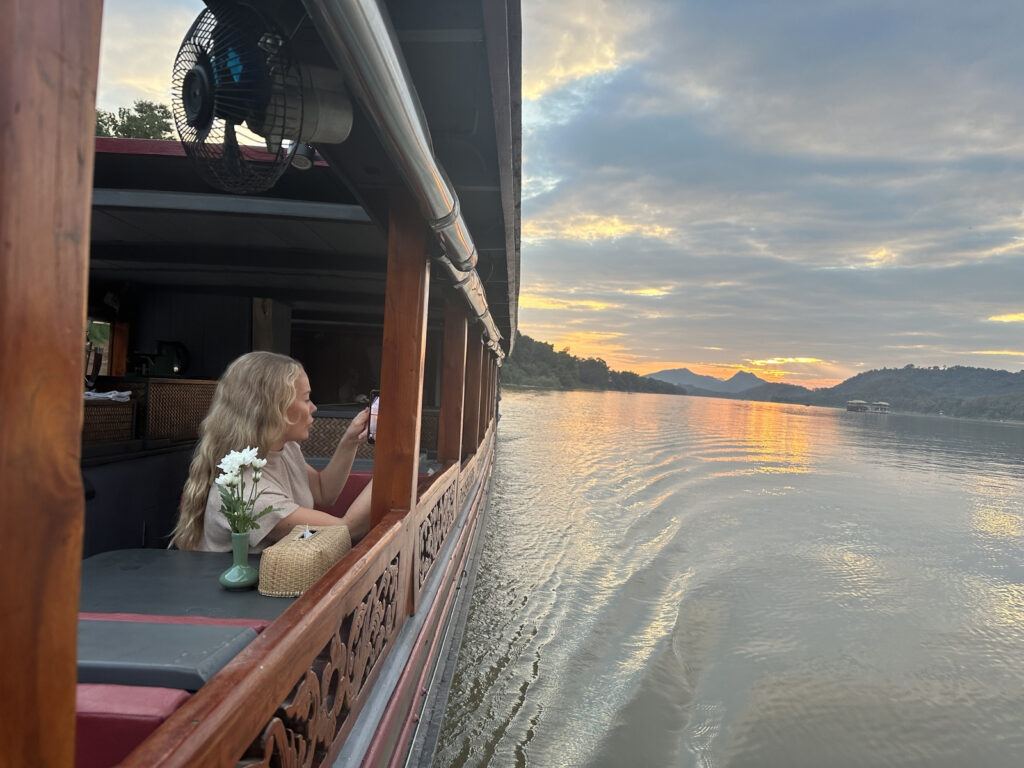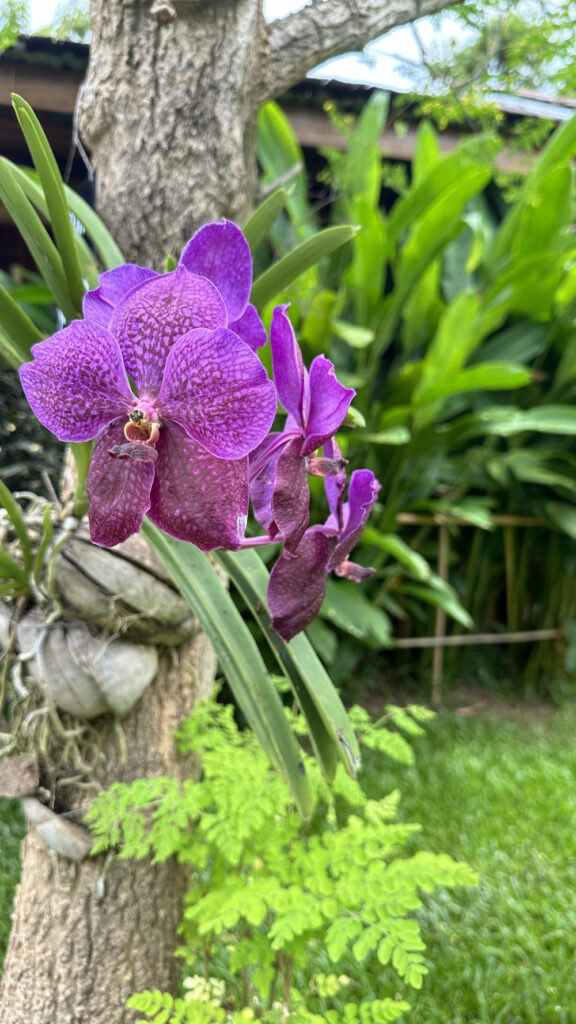Seeking tranquility in nature?
Luang Prabang, hidden within the Northern Laos landscape, offers a natural vacation far from the city bustle.
Experience crystal-clear waterfalls, sacred mountain views, and Mekong River’s calm—all while exploring the intersection of verdant nature and rich cultural tapestry.
Get ready for an authentic journey into the heart of Laos’ serene outdoors.
Key Takeaways
- Luang Prabang, a city in Northern Laos, offers a mix of historical, cultural, and natural attractions, including the largest waterfall in the region, Kuang Si Waterfall, and the iconic Mekong River for sunset cruises and water-based activities.
- The region around Luang Prabang is ripe for exploration with hidden natural gems like Tad Sae Waterfall and Pak Ou Caves, plus a wealth of outdoor activities such as hiking, mountain biking, and ethical wildlife encounters for an immersive experience.
- Cultural significance is deeply interwoven with Luang Prabang’s natural landscapes, evident in its Buddhist temples and rituals, like the daily almsgiving ceremony. The best times to visit range from the ideal weather of September to November, to the vibrant wildlife and birdwatching opportunities from March to May.
Embracing the Serenity of Luang Prabang
Nestled in the bosom of Northern Laos, Luang Prabang is a vibrant tapestry of cultural, religious, and architectural heritage nestled in the heart of a breathtaking natural landscape. As you stroll through the ancient streets, you will be transported back in time, where the echoes of the bygone era of Lao kings and Buddhist monks resonate amidst the verdant mountains and tranquil waters of the Mekong River and Nam Khan River. This enchanting city is a gem in the Lao People’s Democratic Republic, offering a unique experience for travelers.
But the charm of Luang Prabang extends beyond its historical allure. The lush jungles, scenic trails, and enchanting waterfalls offer a haven for nature lovers and adventure seekers alike. The city’s unique blend of cultural heritage and natural beauty makes it a must-visit destination for any nature vacation.
Let’s begin the journey!
Kuang Si Waterfall: A Natural Marvel
Begin your exploration of Luang Prabang with a visit to the region’s awe-inspiring natural marvel — the Kuang Si Waterfall.
Imagine a cascade of turquoise waters flowing down dramatic cliffs, creating a spectacular display of nature’s beauty — that’s Kuang Si Waterfall for you, the largest waterfall in the Luang Prabang region.
The waterfall’s serene landscape offers visitors a chance to immerse in nature’s spectacle, whether it’s swimming in the refreshing three-tiered pools, picnicking amidst the lush greenery, or hiking to the higher pools for a unique perspective and experience.
A short 40-minute drive from the city of Luang Prabang, the Kuang Si Waterfall is easily accessible and provides a memorable half-day adventure. As you revel in the waterfall’s splendor, remember that it is a protected area, and local conservation efforts prohibit the use of soap and shampoo in the swimming areas to keep it pristine.
Mekong River Adventures
Next, embark on an adventure in Southeast Asia on the Mekong River.
The Mekong River, often referred to as the lifeline of Laos, presents a charming adventure that weaves the region’s stunning landscapes with glimpses of local life. As you embark on a tranquil cruise, encapsulated by the surrounding mountains, and witnessing the riverbanks teeming with life. As the sun sets, the Mekong’s charm is further enhanced, offering a serene end to a day full of exploration.
For the more adventurous, the Mekong and Nam Khan offer a plethora of water-based activities. From kayaking to traditional fishing practices, you can engage in a range of experiences aboard traditional wooden longboats. You can even delve into local culture by exploring riverside villages, offering a glimpse into the inhabitants’ daily lives.
Mystical Mount Phousi
Next on the itinerary is the mystical Mount Phousi, another gem of Luang Prabang.
The spiritual journey up Mount Phousi is as rewarding as the panoramic views from its summit. Ascending over 300 steps to the top, you’ll pass by Buddhist statues and shrines, culminating at the Wat Chom Si temple, which imparts a sense of tranquility and reverence.
The ascent itself is an intimate encounter with Buddhist spirituality, offering a serene retreat from the hustle and bustle of the city below.
Reaching the summit, you’ll be rewarded with a striking 360-degree view of Luang Prabang, the Mekong River, and its ancient Buddhist temples, especially stunning at sunrise and sunset.
This vista, encompassing the ethnic Lao city and its breathtaking natural surroundings, is an experience not to be missed during your nature vacation in Luang Prabang. But the allure of Luang Prabang doesn’t end here. Let’s uncover Laos’ hidden nature gems.
Unveiling Laos’ Hidden Nature Gems
Beyond the tranquil streets of Luang Prabang, Northern Laos is a treasure chest of hidden gems waiting to be discovered.
From serene escapes on the banks of the Nam Ou River in Nong Khiaw to the impressive Tad Fane waterfall in Dong Hua Sao National Protected Area, each site offers a unique glimpse into Laos’ diverse natural beauty.
Whether you’re exploring the community of Ban Pom Ngam through the seven-kilometer long cave system of Kong Lor Cave or trekking with rescued elephants at MandaLao Elephant Conservation, each experience is a testament to the sustainable practices that Laos holds dear, taking into account the lao soung account.
Let’s explore two of these enchanting destinations in more detail.
Tad Sae Waterfall: The Secluded Escape
Your adventure to the Tad Sae Waterfall begins even before you reach the site. This secluded gem is only accessible by boat, adding an element of excitement to your journey. As you disembark, you’ll be greeted by the calming sounds of the waterfall and the whispering trees, offering an escape from the world where serenity reigns supreme.
As you soak in the tranquility of the jungle, you’ll find a range of amenities at your disposal, including:
- Restaurants
- A coffee shop
- Changing rooms
- Souvenir stalls
These amenities ensure your time at the waterfall is comfortable and memorable.
Next, embark on a pilgrimage into the past at the Pak Ou Caves.
Pak Ou Caves: A Pilgrimage into the Past
Your journey to the Pak Ou Caves is a step back in time.
Set in limestone cliffs along the Mekong River, these caves are a spiritual sanctuary, housing thousands of Buddha statues that contribute to the site’s cultural and religious significance. Accessing the caves is an adventure in itself, requiring a climb of approximately 80 steps to the lower cave, Tham Ting, and an additional ascent of around 200 steps to the upper cave, Tham Phum.
As you explore the darker areas of the caves, make sure to bring a flashlight and take time to enjoy the views from the top. Remember, the Pak Ou Caves are more than just a tourist attraction; they’re a testament to Laos’ deep-seated Buddhist culture and history.
Having explored the serene landscapes of Luang Prabang, let’s venture outdoors for more adventures.
Immersive Outdoor Activities in Luang Prabang
For those seeking a more active nature vacation, Luang Prabang offers a variety of immersive outdoor activities.
Whether it’s tubing along the Nam Khan river, hiking through lush forests, or mountain biking across rugged terrains, there’s an adventure waiting for every thrill-seeker.
As you navigate through the city’s natural landscapes, you’ll appreciate the breathtaking views that accompany every twist and turn.
And the best part? The varied villages and sites nestled along the river allow you to take in the scenery, providing opportunities to immerse in the natural beauty of Luang Prabang.
Let’s explore some of these outdoor activities in more detail.
Hiking Trails and Mountain Biking Paths
Luang Prabang’s dramatic mountains are a paradise for hiking and mountain biking enthusiasts. The region’s rich biodiversity and stunning vistas make every trail an exciting venture into the wilderness. Whether you’re a seasoned adventurer or a casual biker, the 29.7-mile Luang Prabang Cycle Route offers moderate challenges along picturesque rural landscapes and local Laotian villages.
Cyclists venturing onto the second half of the route will experience a more rural adventure along dirt roads through villages and rice paddies in a mountainous country. Given the rough trail conditions, a decent mountain bike is recommended for this part of the journey and many resorts offer rentals.
Don’t forget the wildlife encounters that Luang Prabang has to offer.
Ethical Wildlife Encounters
Your nature vacation in Luang Prabang offers more than just stunning landscapes.
It also provides opportunities for ethical wildlife encounters, such as visiting the Kuang Si Bear Rescue Centre. This sanctuary provides a refuge to over 20 rescued Asiatic Black Bears, exemplifying Laos’ commitment to wildlife conservation.
For bird watching enthusiasts, the period from March to May is ideal as it offers the opportunity to observe migrating birds in the region.
And if you’re visiting between November and February, you can enjoy watching animals more active and easily observed during the cooler months.
While exploring the rich biodiversity of Luang Prabang, it’s also worth delving into the cultural intersections between Buddhism and nature.
Cultural Intersections: Buddhism and Nature
In Luang Prabang, Buddhism is not just a religion; it’s a way of life.
The profound connection between spirituality and locality is evident in the city’s numerous Buddhist temples and rituals, reflecting the deep influence of Buddhism since the 14th century. And the best part? This spiritual journey is intimately intertwined with nature, providing a unique cultural experience for any nature vacation.
Whether it’s exploring the historical significance of Wat Xieng Thong or witnessing the humble dawn ritual of the almsgiving ceremony, each experience offers a window into the city’s spiritual life. In the next sections, we’ll explore these cultural intersections in more detail.
Temples Amidst the Trees
Nestled amidst the verdant greenery of Luang Prabang is the historically significant Wat Xieng Thong.
Known for its role in the coronation of Lao kings, this Buddhist temple is a significant monument of religion, royalty, and traditional art. The temple’s architecture, a blend of Lane Xang Arts style and intricate gold stenciling, stands as a testament to Luang Prabang’s rich cultural heritage.
But Wat Xieng Thong is more than just a historical monument. Its compound, composed of:
- small halls
- stupas with Buddha images
- a royal funerary carriage house
- a reclining Buddha sanctuary
blends seamlessly with the natural environment, offering a unique experience of temples amidst the trees.
Next, witness a humble dawn ritual that reflects the profound connection between spirituality and locality in Luang Prabang.
Almsgiving Ceremony: A Humble Dawn Ritual
Experiencing the almsgiving ceremony, deeply rooted in Theravada Buddhism, is a humble experience that reflects the symbiotic relationship between monks and almsgivers. As the sun begins to rise, locals kneel on the streets, offering mainly sticky rice and occasionally other food items to the barefoot monks walking in contemplative silence.
This daily ceremony is a profound testament to the spiritual life of the community in Luang Prabang. Visitors are welcome to witness this ritual or participate by offering alms, following certain guidelines for respect and devotion.
Having traversed the serene landscapes and cultural intersections of Luang Prabang, it’s time to look at some practical information for planning your nature vacation.
Planning Your Natural Vacation to Luang Prabang
Planning your nature vacation to Luang Prabang is an exciting part of your journey. From determining the best times to visit to choosing the perfect activities, each step of your plan brings you closer to the unforgettable vacation awaiting you in this UNESCO World Heritage Site.
In the next sections, we’ll discuss some considerations to help you plan your trip.
Best Times to Visit
When planning your nature vacation, timing is crucial. The best time to visit Luang Prabang is during the high season, from September to November. During this period, the weather is ideal, with an average temperature of around 73°F and minimal precipitation, making it perfect for exploring the city’s natural and cultural attractions.
If you’re an avid bird watcher or wildlife enthusiast, consider visiting between March and May. Despite being the low season due to higher temperatures and increased rainfall, this period offers the opportunity to observe migrating birds and active wildlife.
Accommodations like No Other
The Namkhan Hotel and Resort in Luang Prabang cater to a wide range of traveler needs, from luxury rooms to riverside villas. Some options include:
- Deluxe rooms and villas: Offering guests exceptional views along with upscale amenities along the Nam Khan River, providing an unforgettable stay.
- Premium glamping experience: For those looking to immerse in nature, luxury tents that immerse you in nature without sacrificing comfort.
- Various Experiences: From a visit to the local organic farm to cooking classes and traditional bamboo weaving. There’s a unique experience for every adventurer.
If you decide to stay somewhere else, it’s important to note that facilities like air conditioning, cable TV, and internet might not be widely available, especially at lower price points.
However, many budget guesthouses offer free Wi-Fi, enabling you to stay connected during your nature vacation. Having planned your trip to Luang Prabang, how about exploring the national parks of Laos?
Beyond Luang Prabang: National Parks of Laos
Beyond the tranquil streets of Luang Prabang, Laos boasts a range of biodiversity conservation areas and national parks, each playing a crucial role in wildlife conservation and offering unique natural experiences.
From the bird-rich Nam Ha to the elephant and tiger-supporting Phou Khao Khuay, each park offers a unique glimpse into Laos’ diverse wildlife.
Whether it’s bird watching in Nam Ha, encountering gibbons in Bokeo, or exploring the rare plants and religious sites of Dong Natad, each experience contributes to the preservation of these natural habitats.
To truly appreciate the diversity of nature’s beauty, compare the lush greenery of Luang Prabang with the dramatic sub-Arctic environment of Denali National Park & Preserve.
Denali National Park: A Contrast in Wilderness
When it comes to contrasting landscapes, few places can compare to Denali National Park & Preserve.
Located in Alaska, Denali presents a dramatic sub-Arctic environment with snow-covered peaks and tundra landscapes, providing a stark contrast to the lush, green surroundings of Luang Prabang.
Denali encompasses two million acres of designated wilderness, preserving an intact ecosystem home to a diverse range of sub-Arctic wildlife.
This contrast underlines the stunning diversity of nature’s beauty, reminding us of the countless adventures that await beyond Luang Prabang.
Laos Offers Nature Vacations Like No Other Place
From the cascading waters of Kuang Si Waterfall to the tranquil dawn ritual of the almsgiving ceremony, Luang Prabang offers a unique blend of natural beauty and cultural heritage.
Whether you’re exploring the banks of the Mekong River, ascending the sacred Mount Phousi, or immersing in the local lifestyle, every experience is a testament to the city’s serene charm.
As you plan your nature vacation, remember that Luang Prabang is more than a destination; it’s a journey into the heart of Laos’ natural and cultural wonders.
Frequently Asked Questions
How can I enjoy a day off from my Luang Prabang vacation?
You can take a break from your regular routine by planning a day off and enjoying your favorite activities, such as a spa night or a special dinner out. (Date not needed)
What is the most popular vacation site in Laos?
Luang Prabang is the most popular vacation site and top destination for travelers. From serene waterfalls to tranquil temples, you can find a vacation in nature like no other place here. But ultimately, the choice of the most popular site in Laos can depend on individual preferences and interests.
Is Luang Prabang safe?
Yes, Luang Prabang is relatively safe, with rare occurrences of petty crimes like pickpocketing or bag snatching. However, it’s advisable to be cautious in crowded areas or tourist spots.
What are some of the natural attractions in Luang Prabang?
When visiting Luang Prabang, make sure to explore the Kuang Si Waterfall, Mekong River, Mount Phousi, and Pak Ou Caves to experience its natural beauty. These are some of the must-visit attractions that showcase the stunning natural landscape of Luang Prabang.
What is the best time for a nature vacation in Luang Prabang?
The best time for a nature vacation in Luang Prabang is during the high season, from September to November, when the weather is ideal for outdoor activities.

